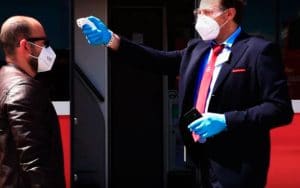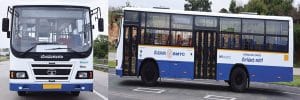The post Covid-19 world order is expected to bring about a drastic change in the bus ecosystem.
Story by Deepti Thore
As the world comes out of the shadow of Covid-19, new world order is in the offing. It is also expected to drive a drastic change in the bus ecosystem. A recent webinar — ‘Outlook On The Bus And Coach Industry Post-Corona’ — organised by Busworld delved on this. It was experts from the field engaging in a discussion that would anticipate as well as accurately pin-point the changes that would affect the bus ecosystem. Witnessing the participation of over 1050 people, the webinar, moderated by Jan Deman, Director, Busworld Academy, saw Dan Pettersson, Senior Vice President Business Unit Chassis, Volvo Bus Corporation, draw attention to the state of bus markets around the world in relation to the pandemic. Stating that many (bus) markets are at different stages of crisis, Pettersson mentioned that some are functioning reasonably well while some others are beset by some additional challenges. He cited the example of Australia where the bus industry continues to operate at a decent speed. “Unlike Australia, a few other markets around the world are facing additional challenges like lockdown still being in force; challenges like currency devaluation and credit crunch,” Pettersson informed.
Of the opinion that markets experiencing additional challenges like currency devaluation and credit crunch are finding the going tough, Pettersson explained that his company is supporting its customers to sustain their businesses. Pointing at the telematics data derived by Volvo, which suggests that the public transportation or city buses are least affected on a global basis as they enjoy certain priority in recovery plans, Pettersson averred, “Each country is working on a recovery plan to revive the economy. This in-turn means that investments in public transportation would be prioritised because of their ability to provide big economic benefits and generating job opportunities.” Stating that politicians are aware of the employment opportunities provided by the bus industry the world over, Pettersson expressed that electrification will either speed up or slow down depending on whether it is part of the national recovery plan. Fearing bankruptcies emerging from smaller tourism company categories, which would potentially lead to consolidation, price pressure and overflow of used buses resulting in a fall of used (tourist) bus prices, he averred, “A rise in demand for urban and intercity bus services globally once normalcy returns will lead to new world order in the bus industry.”
Challenges and opportunities
Expressing worry about buses in many markets around the world standing still, Pettersson mentioned that competitiveness in service standards, comfort and safety will rise to a new level among city bus operators. It would in-turn create new opportunities in the area of prevention and sanitisation measures. Citing an example of a range of new protection and sanitisation features offered by the North American unit of Volvo, Pettersson averred that new design requirements are made necessary. Of the opinion that new seating configurations and use of screens will dot future bus designs, he said that superior ventilation will be of importance. Informing that Volvo has been gradually opening up its production facility all over the world, Pettersson hoped that things will soon get better.
Stating that assessment on recovery, predictions on ramp up and long-term opportunities would be the three key factors that will underline the recovery path of the global bus industry, Marc Hofmann, CEO, CheckMyBus (Germany) explained that demand will come back as the situation improves. Sharing an analysis indicating a slow return of demand in an environment post Covid-19, he cited an example of Italy where there is a 118 increase in utilisation. In Portugal, it is 132 per cent, and in Germany, it is 74 per cent, he added. Co-relating the same to the decrease in infections, Hofmann said, “User interest as well as transactions will grow as more and more bus operators resume operations.” Drawing attention to a few markets around the world where the situation is tense, he averred that where it is improving, a surprising trend is that the elderly are willing to board the bus once again. Hofmann stated that the road to 100 per cent occupancy and in-turn profitable operations will go through measures like entry control, investment, technology and protection of the bus staff.
Digitising for success
Expressing confidence in the bus industry seeing better opportunities coming its way, Hofmann pointed out that live ticket sales and packed terminals will be the thing of the past however. This will drive digitisation, he said. Of the opinion that people are looking at adopting shared mobility rather than invest in a private vehicle for economic and ecological reasons, Hofmann said, “Bus is likely to be a winner in modal split.” On the subject of shuttle services, Tobias Stüber, CEO, Flibco, Luxembourg, stressed on the need to attain full occupancy. He drew attention towards a poll carried out by his company, where a good chunk of the sample audience expressed their preference for door2gate service as being economical. Stüber informed that his company is looking at providing a digital platform and sales platform in the form of driver apps. With the capability to collect and analyse data in real-time, Flibco, which transports roughly 1.9 million passengers per year, is taking data driven decisions.


Operating over 729 buses and employing over 1500 people, Flibco is also leveraging data it gets from the airport regarding departure and arrival times and passenger flow to ramp-up its operations. Looking at delivering safe service to its customers, Flibco, according to Stüber, is monitoring the evolution of the situation closely. Revealing that a pole carried out by his company saw 80 per cent participants say that they were willing to go on a holiday after the government opened the borders, Stüber said, “The use of masks and face protection, gloves, temperature measurement, disinfecting the bus, social distancing, contactless ticketing, retrofitment of air conditioning with additional filters and making it possible to enter the bus from the back door will be of importance.” Informing that inter-city, school and airport bus services are shut down, Pierre-Paul Pharand, CEO, Keolis (Canada) mentioned that the current utilisation levels of the bus industry in his country is about 50 per cent.
Revealing that the employees in the bus industry are facing a financial crisis, Pierre-Paul Pharand said that there is a need to deal with slow emerging post-traumatic stress syndrome apart from the health and safety of employees. Stressing on driver safety, Pharand mentioned the need to make design changes in buses to retain its attractiveness as a public transport medium. Speaking the need to run marketing campaigns to convince people to use public transport (buses and coaches), he averred, “An opportunity lies in increasing the level of service and reducing financial losses.” Informing that social distancing in Canada is two-metres, Pharand said that 52 passenger coaches are being allowed to carry only 14 people as of now. Spelling a curious situation where new buses cannot be bought to support social distancing norms due to paucity of funds, Pharand remarked, “We will have to adapt to what we have, at least until the ridership is back.” Stressing on social distancing as a big challenge, Donald DeVivo, President, DATTCO Inc. and Chairman, American Bus Association(ABA), USA, said that the need to return to full occupancy is quickly emerging as it is turning out to be impractical to operate buses with less occupancy.
Some bus sectors worse off than others
Drawing attention to the US bus industry contributing 15 billion revenue and 1,00,000 motorcoach jobs, DeVivo said that roughly 88,834 jobs in the motorcoach sector (summing up to six-billion dollars in terms of wages) have been impacted . These amount to an output of USD 15 billion approximately, he added. Fearing that two-thirds of motorcoach industry activity will be lost in 2020 (including the loss of 64,000 jobs and about USD 11 billion dollars in sales), DeVivo averred that the school bus industry is completely shut down. Citing that motorcoaches are providing scheduled intercity services, he explained that commuter services are limiting themselves to essential workers and charter services are non-functioning. Informing that transit service ridership has drastically reduced, DeVivo said, “There is a long way to go, and with a lot of help from the government.” Hoping an early return of students to university campuses, to college sports, albeit with safety and security measures in place, he expressed that things will get back to normal by spring hopefully.

Stating that the bus industry in India faced numerous challenges, D.R. Dharmaraj, Joint Secretary, BOCI, India, mentioned that the burden of maintaining the fleet and paying the employees is making the situation complex. Revealing that there are 1.5 million private buses and 0.15 million government owned buses in India, Dharmaraj averred that utilisation came to a near standstill from a peak of about 300 million trips by private buses per day amd 75 million trips by government per day during the two months lockdown period. Stressing upon the Indian bus industry contributing close to eight-per cent of the GDP, he said that not much help is coming its way for it to recover quickly. Stating that it is becoming difficult for bus operators to honour their loans, Dharmaraj explained that many jobs in the field have been lost. Citing an example of Bengaluru Municipal Transport Corporation, which has not been able to run a single of its 6000 bus fleet during the lockdown, he said that the economic challenges are mounting as the passenger count per bus is down from 80 passengers per bus per trip to 20 passenger per bus per trip in the post-Covid-19 environment.
Of the opinion that intercity buses will take a long time before they can operate at full capacity soon, D. R. Dharmaraj said that the limitation of funds is likely to pose a big challenge in expanding the bus count if the number of buses were to be operated with norms like social distancing were to be taken into account. He urged the government to provide the necessary financial assistance to the bus industry in India. Stating that the fuel costs (which account for 40 per cent of the operating costs in buses) should be reduced (India saw a steep rise in fuel cost in June 2020), Dharmaraj said that peak hours should be staggered owing to social distancing at the time when there is maximum flow of commuters. Expressing that the government should reduce vehicle tax, GST and waive off the interest on loan, he remarked that tourist buses could be temporarily used for public transportation services to account for the shortfall.
































